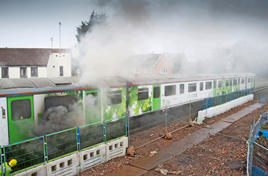RAIL is shown a new two-road strip-out shed where D-Stock vehicles will be prepared for conversion, while plans are at an advanced stage to build a tented area in the summer in front of Vivarail’s main four-road workshop, to accommodate up to nine cars. This is so the company can achieve an output of two finished two-car or three-car D-Trains per month by the turn of the year, with the first batch ready to enter traffic in January.
Before then, it is expected that the first production train will be completed in November as a DEMU, to join 230001 in traffic, while the battery train will have received electromagnetic compatibility approval by then to provide customers with the full range of options.
“We’ve been speaking to a lot of people about forthcoming franchises, which Department for Transport rules state I can’t talk about,” adds Shooter. “But we have people doing detailed design work to turn this place into a production facility, so we can start to build a fleet of these trains, to fulfil firm orders.”
Between now and then Vivarail will have to overcome one final hurdle, which is the more competitive marketplace to have emerged since the D-Train project began. With the pace of NR’s electrification works having slowed, and many projects such as the Midland Main Line now being placed on hold, stock cascades are being affected. More operators will now be reconsidering their options for new stock.
Without new overhead wires, one such bi-modal alternative option to the D-Train to have emerged recently is the Class 319 Flex train. Announced by rolling stock owning company Porterbrook in December (RAIL 818, 819), it would mean diesel-powered alternators being fitted beneath the driving cars of EMUs that are currently being sent off lease by Govia Thameslink Railway from its Thameslink services, providing a secondary power source.
Shooter feels that this merely reinforces the market’s need for D-Trains, and serves as a positive reminder of the strong appetite for hybrid trains running either as EMU/DMU or in EMU/battery configurations.
He also points to the relative advantages his product has over the ‘319s’, and concludes: “The ‘319’ is an interesting product - I’ve known it since specifying it in the 1980s , but it has its place. It doesn’t have the flexibility, power-to-weight ratio or the acceleration of the D-Train, and it’s more expensive to run as it will need more fuel.
“The D-Train can also run as a two-, three- or four-car unit or whatever, whereas the ‘319’ runs pretty much in a fixed formation. So I’d say the ‘319’ is the right train in some circumstances, and good luck to Porterbrook.
“The majority of people like the ‘crowd busting’ layout of the D-Train, too, and we can seat 44 in the saloon and another 100 standing. Dwell time is becoming more and more important, so having a train like ours is seen as very desirable. You can get 400 on a three-car D-Train, which is much more than a ‘319’ which has lots of 3+2 seats. And we can still do 30-second station stops.
“This is an emerging market, and there are opportunities out there, so this won’t be the last now that Network Rail has got into some difficulty with electrification.”
This feature was published in RAIL 825 on 22nd April 2017
















Login to comment
Comments
No comments have been made yet.